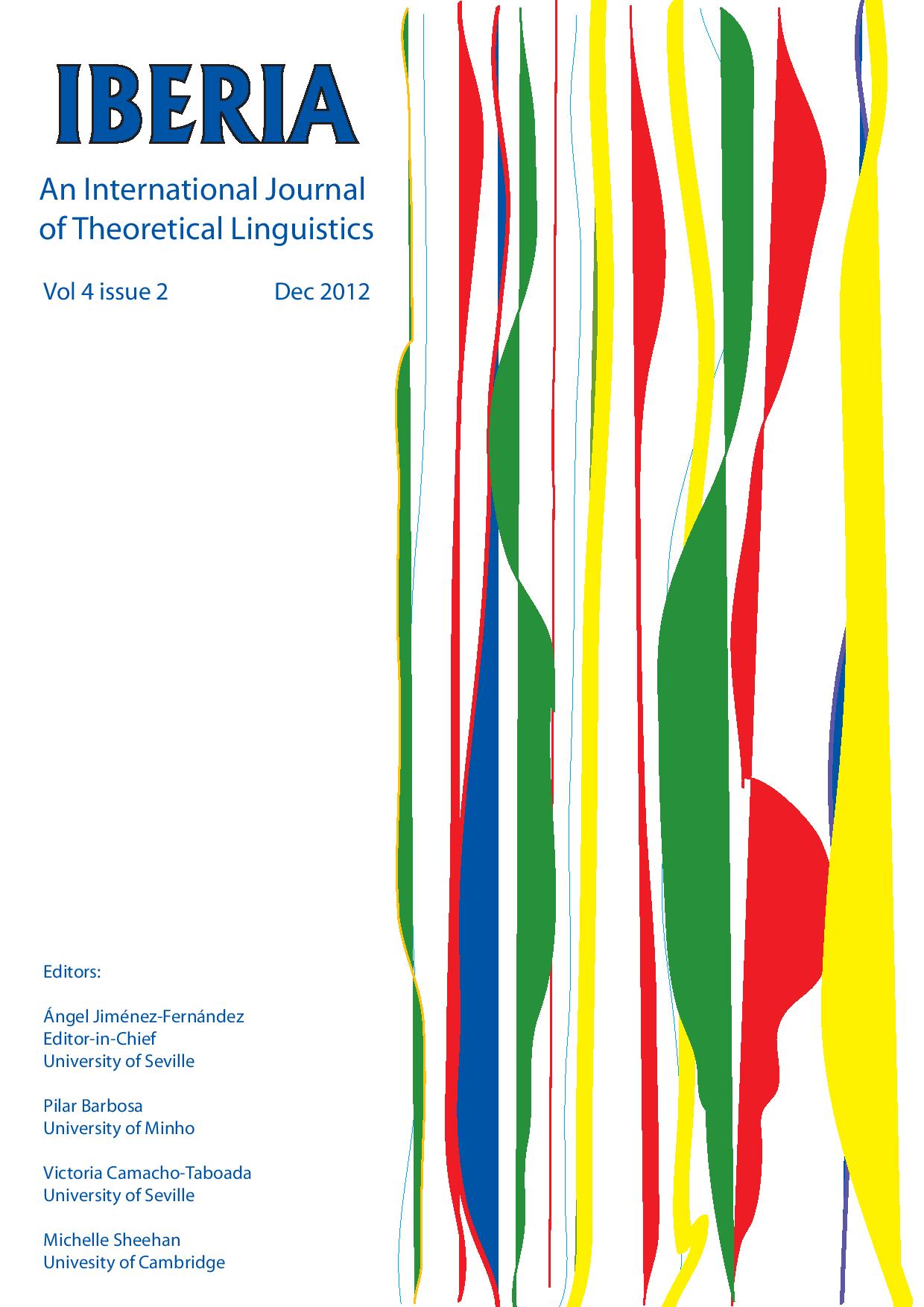Dissociating Japanese scrambling from controller movement
Palabras clave:
scrambling, control, weak crossover, binding, JapaneseResumen
This paper argues against Takano’s (2010) analysis of weak crossover effects in Japanese object control constructions. In his paper, it is shown that only a pronoun contained in a controller can be bound by a scrambled quantifier. He claims that this binding relation is established within the control clause by clause-internal scrambling on the assumption that (i) long distance scrambling in general cannot create a new binding relation and (ii) obligatory control is derived by movement of a controller. In opposition to his claim, I demonstrate that the contrast at issue actually stems from general properties of Japanese scrambling. That is, (i) clause- internal scrambling of the direct object over the indirect object is A- movement while that over the subject is A'ʹ-movement, and (ii) long distance scrambling out of control clauses patterns with clause-internal scrambling. In consequence of these properties, it is predicted that the pronoun in question can be bound as long as it is contained in the indirect object, which in the case of object control constructions happens to be a controller.
Descargas
Citas
Boeckx, Cedric. 2000. A note on contraction. Linguistic Inquiry 31, 357-366. Boeckx, Cedric & Nobert Hornstein. 2003. Reply to “control is not movement”.
Linguistic Inquiry 34, 269-280.
Boeckx, Cedric & Nobert Hornstein. 2004. Movement under control. Linguistic
Inquiry 35, 431-452.
Boeckx, Cedric & Nobert Hornstein. 2006. The virtues of control as movement.
Syntax 9, 118-130.
Boeckx, Cedric, Nobert Hornstein & Jairo Nunes. 2010. Control as Movement.
Cambridge: Cambridge University Press.
Bowers, John. 1973. Grammatical Relations. Ph.D. dissertation, MIT. Bowers, John. 2008. On reducing control to movement. Syntax 11, 125-143.
Chomsky, Noam. 1973. Conditions on transformations. In Stephen R. Anderson & Paul Kiparsky (eds.), A festschrift for Morris Halle. 232-286. New York: Holt, Reinhart & Winston.
Chomsky, Noam. 1981. Lectures on Government and Binding. Dordrecht: Foris.
Chomsky, Noam. 1993. A minimalist program for linguistic theory. In Kenneth Hale & Samuel J. Keyser (eds.), The View from Building 20. 1-52. Cambridge, MA: MIT Press.
Chomsky, Noam. 2000. Minimalist inquiries: The framework. In Roger Martin, David Michaels & Juan Uriagereka (eds.), Step by Step: Essays on Minimalist Syntax in Honor of Howard Lasnik. 89-155. Cambridge, MA: MIT Press.
Chomsky, Noam. 2001. Derivation by phase. In Michael Kenstowicz (ed.), Ken Hale: A Life in Language. 1-52. Cambridge, MA: MIT Press.
Chomsky, Noam. 2004. Beyond explanatory adequacy. In Adriana Belletti (ed.),
Structures and Beyond: The Cartography of Syntactic Structures. 104-131. Oxford: Oxford University Press.
Chomsky, Noam. 2007. Approaching UG from below. In Uli Sauerland & Hans Martin Gärtner (eds.), Interfaces + Recursion = Language? 1-29. New York: Mouton de Gruyter.
Chomsky, Noam. 2008. On phases. In Robert Freidin, Carlos Peregrín Otero & Maria Luisa Zubizarreta (eds.), Foundational Issues in Linguistic Theory: Essays in Honor of Jean-Roger Vergnaud. 133-166. Cambridge, MA: MIT Press.
Fujii, Tomohiro. 2006. Some Theoretical Issues in Japanese Control. Ph.D. dissertation, University of Maryland.
Hiraiwa, Ken. 2010. Scrambling to the Edge. Syntax 13, 133-164.
Hoji, Hajima. 1985. Logical Form Constraints and Configurational Structures in
Japanese. Ph.D. dissertation, University of Washington.
Hornstein, Nobert. 1999. Movement and control. Linguistic Inquiry 30, 69-96.
Hornstein, Nobert. 2001. Move! A Minimalist Theory of Construal. Oxford: Blackwell.
Hornstein, Nobert. 2003. On control. In Raudall Hendric (ed.), Minimalist Syntax. 6-81. Oxford: Blackwell.
Kawamura, Tomoko. 2004. A feature-checking analysis of Japanese scrambling. Journal of Linguistics 40, 45-68.
Miyagawa, Shigeru. 1997. Against optional scrambling. Linguistic Inquiry 28, 1- 25.
Miyagawa, Shigeru. 2003. A-movement scrambling and options without optionality. In Samin Karimi (ed.), Word Order and Scrambling. 177-200. Oxford: Blackwell.
Miyagawa, Shigeru. 2010. Why Agree? Why Move? Unifying Agreement-Based and Discourse-Configurational Languages. Cambridge, MA: MIT Press.
Nemoto, Naoko. 1993. Chains and Case Positions: A Study from Scrambling in
Japanese. Ph.D. dissertation, University of Connecticut, Storrs.
O’Neil, John. 1995. Out of control. In Jill Beckman (ed.), NELS 25. 361-371. Amherst: University of Massachusetts, Graduate Linguistic Student Association.
Saito, Mamoru. 1992. Long distance scrambling in Japanese. Journal of East Asian Linguistics 1, 69-118.
Tada, Hiroyuki. 1993. A/A-bar Partition in Derivation. Ph.D. dissertation, MIT. Takano, Yuji. 1998. Object shift and scrambling. Natural Language and Linguistic
Theory 16, 817-889.
Takano, Yuji. 2010. Scrambling and control. Linguistic Inquiry 41, 83-110.
Uchibori, Asako. 2000. The Syntax of Subjunctive Complements: Evidence from Japanese. Ph.D. dissertation, University of Connecticut, Storrs.
Yatsushiro, Kazuko. 2003. VP internal scrambling. Journal of East Asian Linguistics 12, 141-170.
Yoshimoto, Keisuke. 2012. The left periphery of CP phases in Japanese. Acta Linguistica Hungarica 59, 339-384.
Cómo citar
Número
Sección
Licencia
Las ediciones impresa y electrónica de esta Revista son editadas por el Secretariado de Publicaciones de la Universidad de Sevilla, siendo necesario citar la procedencia en cualquier reproducción parcial o total.Salvo indicación contraria, todos los contenidos de la edición electrónica se distribuyen bajo una licencia de uso y distribución “Creative Commons Atribución-NoComercial-SinDerivar 4.0 Internacional”

